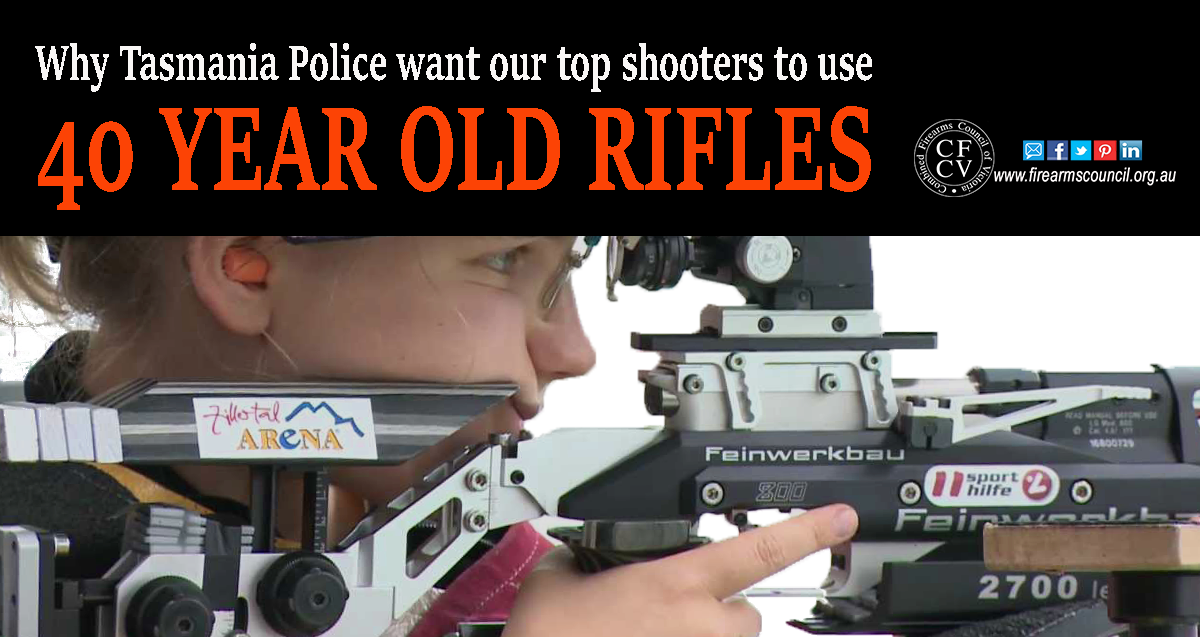Tasmania Police target Olympic and disabled shooters – and their own officers – in gun crackdown

However, they are so poorly thought out, they could prohibit all of the firearms being used at the Rio Olympics.
Tasmania’s Firearm Services has circulated this guideline (click this link to see it) for comment on how it proposes to administer a key provision in Tasmania’s Firearms Act, which prohibits firearms that ‘substantially duplicates’ the appearance of ‘rapid’ fire firearms such as submachine guns.
While a similar provision applies in Victoria, the Tasmanian guidelines use ‘features’ which show a poor understanding of what firearms shooters use.
Problem #1: What the guidelines would prohibit
The guidelines will require firearms to be considered for re-categorisation if they have a pistol grip, a fore-end shroud, a detachable magazine shroud or skeleton / folding/ adjustable stock.
Let me introduce you to the Feinwerkbau 800.
As you can see, this firearm has a pistol style grip, and a skeleton type stock which is adjustable in just about every possible way. It also has a fore-end which partly shrouds the barrel.
It’s also an air rifle. It’s an off-the-shelf item for the Olympic discipline of air rifle shooting. Similar variants exist for the Olympic smallbore (0.22) shooting events as well as the Commonwealth games fullbore events.
They are used for both mens and womens events as well as at the Paralympics, World Championships and the World Police and Fire Games. It is the firearm shown in the image at the top of this post.
Non-adjustable stocks have not existed in these events for over 40 years, maybe 50.
If adjustable stocks and pistol grips were enough to warrant firearms to be put up for re-categorisation, it would capture every rifle used at Rio.
It would create uncertainty for anyone looking to buy a new firearm or anyone traveling to Tasmania with one.
Tasmania would not be able to host major events such as the Commonwealth Games or World Championships.
It would also work against the National Firearms Agreement, which expressly includes “major sporting events as the Commonwealth Games, Olympic Games or World Championships” as providing ‘genuine reason’ for licensing.
The open-endness of the proposed features, as worded, has the potential to create uncertainty over classifications where the opposite is needed, for the benefit of importers, the shooting community and regulators.
We have no doubt the Tasmania Police did not intend for that interpretation to apply to the shooting sports referred to above, but their “imaginative” use of terminology is the result of trying to be “too smart by half” and evident failure to consult shooting interests.
Problem #2: The pictures in the guidelines tell another story
The guidelines show examples of firearms which are prohibited.
While it is easy to see their intent, the words used in the guidelines do not match the examples they used. The Tasmania Police cannot have it both ways: they need to be a lot clearer about what they are or are not trying to achieve.
Problem #3: No provision for review
The guidelines provide no provision for review of reclassification.
Tasmania Police should also be wary of the fact that similar provision in Victoria has resulted in law suits from suppliers: less certainty in the guideline in Tasmania could enhance that possibility.
Problem #4: Qualifications of the author
A few weeks ago we saw Derryn Hinch offer a range of opinions on the Adler shotgun on 3AW without having any industry qualification or obvious experience with firearms.
We made the point that if 3AW wanted advice on aviation safety, they would seek someone with relevant experience rather than someone who had no qualifications at all.
In much the same way, it concerns us greatly that the Tasmania Police should offer guidelines seemingly drafted by someone with little or no experience with the firearms used across a range of legal civilian activities. Firing a 38 at an indoor range to pass the Police Academy is not adequate.
The Tasmanian Government needs to improve the quality of firearm knowledge available to the Tasmania Police if it wants well informed decisions. It needs to implement an equivalent to the Victorian Firearms Consultative Committee encompassing all aspects of firearm policy development.
Problem #5: What is the problem being solved?
In a similar vein, it is difficult to understand what problem is trying to be solved here.
While we understand Tasmania Police has an obligation to administer the law when it comes to firearms that ‘substantially duplicates’ the appearance of other restricted firearms, the ‘problem’ being addressed is not clear.
Is it about cosmetics, functions or perceived function? ‘Features’ suggest cosmetics, where ‘perceived function’ should be the objective.
Problem #6: Where is the police minister?
As we saw in Victoria last year with the firearm transportation guidelines, it should be up to the police minister, not the regulator, to determine firearms policy.
It is especially wrong for the regulator to seek to determine how ‘substantially duplicates’ should be interpreted when that is not its role. This is a question of law, over which the police have no authority.
The Tasmanian Minister for Police, Fire and Emergency Management, Rene Hidding, is responsible for the policy environment in which the Tasmania Police operates, and that is where issues like this should be dealt with.
Make a submission
While the deadline for submissions was Friday, 29 July, the note accompanying the draft guidelines invite comment after the closing date, so it is not too late. You can send your submission to: firearms.services@police.tas.gov.au.
We’ll be putting in our submission based on this article.
Additional Notes: There has been so much to say about rifles, we haven’t even mentioned shotguns or pistols used in top competition, or firearms used in hunting which raise similar issues.